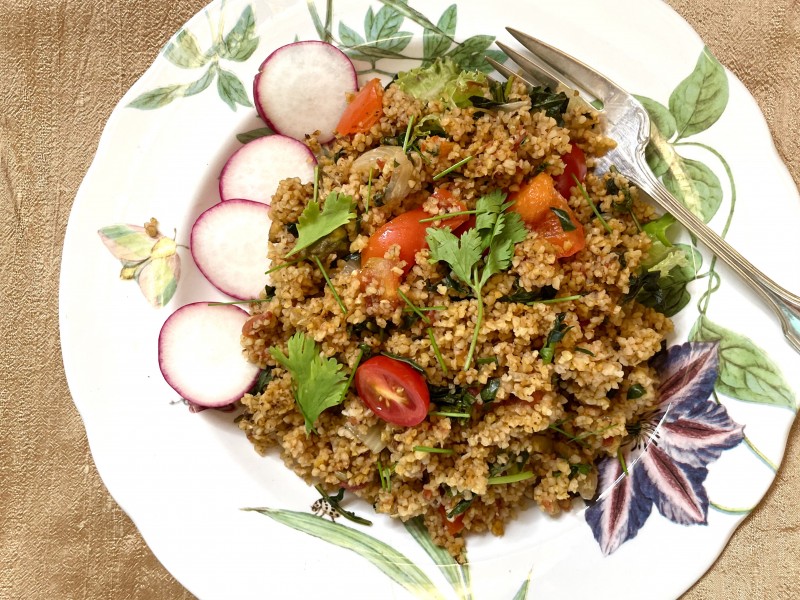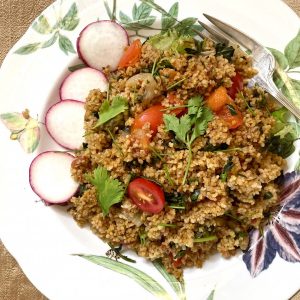Do you know someone who blows hot and cold? We’re talking a volatile personality. You never know what you’ll get. Bulgur, on the other hand, is versatile, not volatile. Enjoyed hot or cold, this high-fiber whole grain’s a sure thing any way you serve it.
Bulgur is an ancient strain of wheat that comes to you cleaned, boiled, dried and sorted from large grain to fine grain. You may know it from tabouli, but these quick-cooking, mild-flavored grains invite a million other meal possibilities. No wonder it’s been the go-to grain across the Middle East for millennia. It hasn’t always been #1 on my whole grain playlist, but after a weekend enjoying bulgur in many different guises, I’m changing that.

How to cook: Easy-peasy — 1 part bulgur to 2 parts liquid, such as water or vegetable broth. Bring the liquid to boil, stir in the grains, cover and reduce heat to low. The grains will soften and absorb. With fine bulgur, you really don’t have to cook it, just let it sit in hot liquid for 15 to 20 minutes. Fluff, and voila, you have basic bulgur.
How to serve: Did I say versatile? Here are three ways to enjoy bulgur, just off the top of my head. All travel well and hold up nicely at a picnic or cookout, even when it’s sweltering.
Breakfast Bulgur
Add chopped fresh and/or dried fruits and nuts to plain cooked bulgur. Sprinkle cinnamon on top and finish with a drizzle each of silan (date syrup) and tahini or a dollop of your favorite nut butter. Indulgent yet nourishing, it’s a great way to jumpstart your morning or light up a ho-hum afternoon.
Green Bulgur
Mince up a bunch of greens and herbs, such as cilantro, dill, mint, chives, parsley and/or arugula. Massage into the plain cooked bulgur until the greens soften and become tender (who doesn’t like a massage?). Drizzle in olive oil and fresh lemon juice, just a little at a time, till you have a soft, tabouli-like consistency. Season generously with sea salt and freshly ground pepper.
Add pinenuts or pistachios to finish, if desired, and serve with as many fresh, steamed or roasted vegetables as you like.
Turkish Bulgur
There are riffs on this dish in Turkey, Syria, Lebanon and Iran. It’s quick to make, big on flavor. I threw this bright dish together in minutes, served it hot at dinner, then enjoyed it all over again for lunch the next day served over greens as a cool salad.

Turkish Bulgur
Ingredients
- 1 cup medium bulgur rinsed
- 1-1/2 cups water or vegetable broth
- 1 ripe tomato chopped tomato (or 1/2 can 15-ounce chopped tomatoes, plus juice from the can)
- 1 tablespoon olive oil
- 1 medium onion chopped (about 1 cup)
- 2 cloves garlic chopped
- 1/2 red pepper chopped
- pinch red pepper flakes
- 1/2 teaspoon turmeric
- 1 teaspoon sumac
- 1 teaspoon coriander
- 2 cups fresh tender greens such as arugula or chard, sliced into bite-sized skinny ribbons**
- sea salt and fresh ground pepper to taste
- 2 tablespoons pomegranate molasses*
- 3 tablespoons toasted pistachios optional
- 1 handful fresh chopped cilantro to finish optional
Instructions
- In a medium saucepan over high heat, bring water or vegetable broth to boil. Pour in bulgur and chopped tomato. Stir together, cover, and reduce heat to low.
- Meanwhile, heat olive oil in a large skillet over medium-high heat. When it starts to shimmer, add chopped onion. Stir and let onion cook for 3 to 5 minutes, or until it softens, smells fragrant, and starts to turn golden. Add chopped garlic and chopped red pepper. Continue cooking, stirring occasionally, until the vegetables soften, another 5 to 8 minutes. Reduce heat to medium.
- Check the bulgur. The grains should have absorbed all the cooking liquid. Give everything a fluff with a fork, then pour the bulgur in with the sautéed vegetables. Stir together gently. Add the turmeric, sumac, coriander, and chiffonade of greens. Using a light hand, stir to combine. Continue to mix together until the greens wilt from the heat into the bulgur and vegetables.
- Season generously with sea salt and fresh ground pepper. Finally, drizzle in the pomegranate molasses (or alternative) and finish with the optional pistachios and cilantro.
Notes

Thank you for these recipes. At church they teach us to eat this way, but people govern themselves, and so we choose how we will live certain laws. The law we have for health is called the Word of Wisdom, and was a revelation that Joseph Smith received about eating meat sparingly, if at all. Although all things have been given for the use of man, it pleases God if we don’t eat meat is what the revelation states in Doctrine and Covenants Section 89 verses 12-15, but if we do, to only eat it in times of winter, cold, or famine. Thanks for these recipes!
Hi, Noa,
Thanks for sharing this. I learn so much from my readers. Almost all faiths include some guidelines about food choices — and most steer away from eating meat. But you’re right — the choices are ultimately our own. I hope you enjoy these plantbased recipes.
Greenly,
Ellen